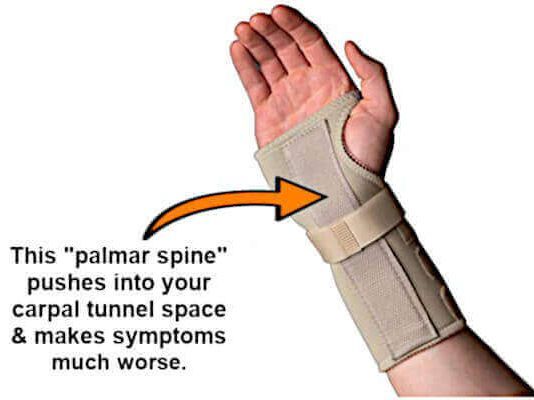Do I Need a Carpal Tunnel Sleeping Splint?
Table of Contents
- When to Call the Doctor
- How a Carpal Tunnel Sleeping Splint Helps
- Splinting Reduces Pressure on the Median Nerve
- Wear a Splint
Only While Sleeping
- Beware the Palmar Spine in Most Splints
- Sleeping Splints to Avoid
- Where Can I Get a Carpal Tunnel Sleeping Splint?
- Does a Carpal Tunnel Sleeping Splint Really Work?
- Do Pain Relievers Help?
- What Worsens Carpal Tunnel Syndrome?
- Summary
- About
Numbness, pain, burning, tingling or soreness in your fingers and palm could be a sign of carpal tunnel syndrome. In fact, it’s the most common hand disorder after arthritis.
Carpal tunnel syndrome is a problem with your
median nerve. That’s one of the main nerves from your arm to your hand. It supplies feeling to your palm and fingers, except your pinky finger.
The problem happens when the median nerve passes through the wrist joint, in a narrow space called the carpal tunnel (that’s where the disorder gets its name). This is a tight, compact area filled with different tissues. So when any of the tissues around the median nerve inflame and swell, they pinch or crush the adjacent nerve.
The inflammation and swelling can be due to one of several reasons. They range from stressed
flexor tendons,
pregnancy, and trauma.
Catching carpal tunnel syndrome early is key to eliminating it. Mild or moderate cases are most easily treated with nonsurgical remedies like rest, activity avoidance, stretching exercises, and night splinting. More
severe cases or those left untreated for a long time, may require more aggressive therapy like myofascial massage, steroid shots or even surgery.
When to Call the Doctor
Early diagnosis and treatment is key to eliminating carpal tunnel syndrome. Consider the following symptoms. If you have any of them then call your doctor for an evaluation.
How a Carpal Tunnel Sleeping Splint Helps
If you have carpal tunnel syndrome, you must wear a wrist splint while sleeping. That’s because most people bend their wrists when asleep. That bending adds extra pressure to your already pinched median nerve. Below are 3 key considerations when splinting your wrist for carpal tunnel:
1) Splinting Reduces Pressure on the Median Nerve
A sleeping splint can help because it prevents your wrist from bending too far. In other words, it keeps it in a straight or “neutral” position.
What's a "Certified" Carpal Tunnel Splint?
These splints are designed specifically for carpal tunnel syndrome. That means:
- They do not have a palmar spine (the flat metal bar on the palm side of the splint).
- They stabilize the wrist with a "lateral" or "dorsal" spine.
2) Wear a Splint Only While Sleeping
Most doctors say “wear the splint 24/7”. Unfortunately, this advice is incorrect in most cases – and for 2 reasons. First, the swelling inside the carpal tunnel space has to be relieved. The only way the body can drain the fluid from a joint is for the joint to move. Otherwise, fluid builds up and pressure increases.
Second, you should not wear a splint while your hand is working. Your wrist is already damaged from carpal tunnel, so why make it strain to do your work PLUS fight the restrictive splint while doing so. This only adds to the stress.
The only exception to daytime splinting is if you know you will over-strain your wrist. If you plan to move furniture or lift something heavy, the splint will prevent wrist over-bending. But be sure to avoid too much stress or force on your wrist.
3) Beware the Palmar Spine in Most Splints
Sleeping Splints to Avoid
The most common splints people use for carpal tunnel syndrome are actually NOT designed for carpal tunnel at all. They should be avoided because using them may cause more harm if you have carpal tunnel syndrome. These splints are:
Where Can I Get a Carpal Tunnel Sleeping Splint?
Certified carpal tunnel sleeping splints are only sold online. As of this writing, there are 6 manufacturers, listed below.
Does a Carpal Tunnel Sleeping Splint Really Work?
Over the past 20 years, multiple studies have shown that wearing a
sleeping splint is much better at relieving symptoms than not wearing one.
Generally, for mild or moderate carpal tunnel syndrome, nocturnal splinting will relieve symptoms in 3-4 weeks. However, if you have multiple symptoms, it may take longer to get good relief.
With more severe carpal tunnel symptoms, night splinting alone is not enough to get relief. Instead, it should be part of a more comprehensive approach. You must include remedies like rest and activity avoidance,
stretching exercises,
heat therapy, and
myofascial release massage. Extremely severe symptoms will likely require
surgery.
Do Pain Relievers Help?
In fact, the most common therapy used by carpal tunnel patients is using pain relievers. In particular, nonsteroidal anti-inflammatory drugs (NSAIDs) are
very good at relieving pain because they reduce swelling (around your median nerve). The most common over-the-counter drugs include:
- Ibuprofen (Advil, Motrin)
- Acetaminophen (Tylenol)
- Naproxen (Aleve, Naproxen)
- Aspirin
It’s important to note that these drugs are only a temporary solution. They’re great for short-term pain relief. But due to their possible
side effects, they should never be used daily for more than 2 weeks.
What Worsens Carpal Tunnel Syndrome?
The whole idea behind any carpal tunnel therapy is to reduce pressure on your median nerve. That means you have to reduce any excess strain on your wrist. This and other factors can greatly reduce your symptoms. They include:
- Avoid excessive twisting or bending your wrist. The more neutral (straight) it is, the less pressure inside.
- Avoid cold environments. Cold fingers and hands can make the pain worse.
- Take frequent rest breaks.
- During the rest breaks, do
quick stretching exercises.
- Do not repeat the same hand and finger motions for prolonged periods of time.
- Switch up tasks to avoid repeating the same motions.
- Maintain
good posture at your workstation.
- Use a relaxed grip or ergonomic tools to reduce grip pressure.
- Avoid
vibration and wear gloves when appropriate.
Summary
A carpal tunnel sleeping splint works well to relieve mild or moderate symptoms of carpal tunnel syndrome. In most cases carpal tunnel symptoms will disappear within a few weeks. However, more severe symptoms will usually require more aggressive therapy, like a sleeping splint PLUS additional simultaneous remedies like carpal tunnel
stretching exercises and
myofascial release massage. Also, never wear a wrist splint during the daytime. And be sure to choose a Certified Carpal Tunnel Splint for sleeping.
About







